One of the things that makes walking the streets of London so enjoyable is a discovery that not only informs about a building or location, but also tells a whole new story about a period in time and what was changing and important in the life of Londoners at that time.
Walk down Queen Victoria Street towards Blackfriars. After passing the church of St. Benet, Paul’s Wharf on your left you will walk past what, at first glance, appears to be a very bland and utilitarian building.
This is the Faraday Building, named after Michael Faraday, an English scientist who experimented with electromagnetism, demonstrated how rotating a coil in a magnetic field could generate electricity and developed the “laws which governs the evolution of electricity by magneto-electric induction”.
The General Post Office (GPO) opened the first London telephone exchange on this site in 1902 with the existing building being completed and officially opened in 1933 to accommodate the very significant growth in telephone services across London. It was designed by A.R. Myers, an architect of the Office of Works who was responsible for the design of a considerable number of Telephone Exchange buildings and Post Offices across the country.
Following completion, the height of the building was very controversial as it blocked the view of St. Paul’s Cathedral from the river. It led to the planning regulations and by-laws that protected sight-lines to the cathedral and restricted the height of buildings. To this day along Queen Victoria Street, the Faraday Building is still the tallest between cathedral and river, as can be clearly seen in the following photo where the Faraday Building is on the right, well above the surrounding buildings.
The Faraday Building was the main telephone exchange for London and also the hub for international circuits with the majority of international calls being routed via the manual switchboards in the building.
Look just above the line of the second set of windows and in the position associated with a key stone, there are a series of carvings, one above each window, that tell the story of what was state of the art telecommunications at the time the building was constructed.
Walking down towards Blackfriars, the first carving is the Telephone.
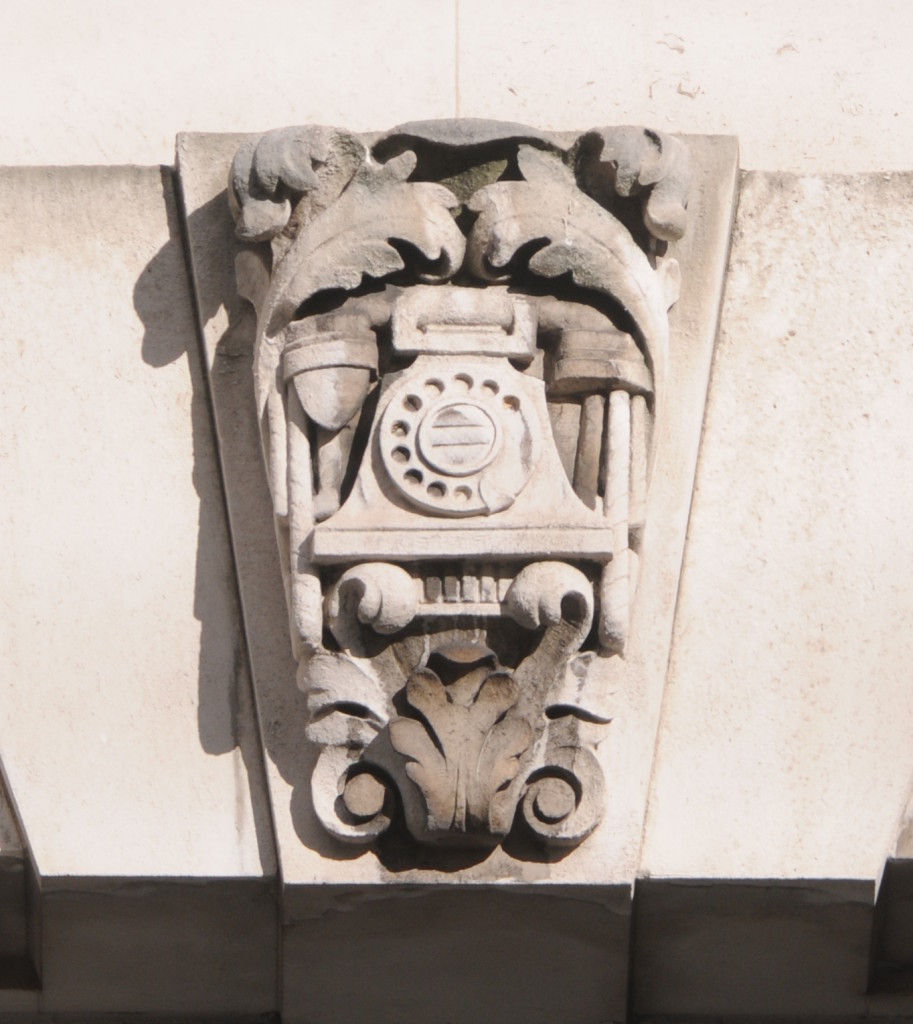 This type of telephone at the time, was cutting edge technology. It utilised a dial that sent pulses to the telephone exchange when the dial was released from the chosen number position, to tell equipment at the exchange what number was being dialled. Prior to the use of a dial, all calls were put through manually, requiring an initial conversation with an operator which would then start a series of manual patching to put you through to your destination. A technique that worked when few people had telephones, but a model that could not cope with the growth of telephones as the 20th Century progressed.
This type of telephone at the time, was cutting edge technology. It utilised a dial that sent pulses to the telephone exchange when the dial was released from the chosen number position, to tell equipment at the exchange what number was being dialled. Prior to the use of a dial, all calls were put through manually, requiring an initial conversation with an operator which would then start a series of manual patching to put you through to your destination. A technique that worked when few people had telephones, but a model that could not cope with the growth of telephones as the 20th Century progressed.
The next carving shows a series of coded pulses crossing a disk, possibly a representation of the world.
Coded pulses were the means by which information was transmitted about the call to be made. When a dial was turned on a telephone, the release of the dial would cause it to return to its original position and as it returned it would open and close an electrical contact thereby sending pulses to the telephone exchange.
I have seen a number of interpretations for the next carving, but to me these are very clearly the cables that carry telephone signals. There is an outer loop of cable and within the centre, the ends of the cables which have their protective sheath cut back leaving the individual conductors within exposed.
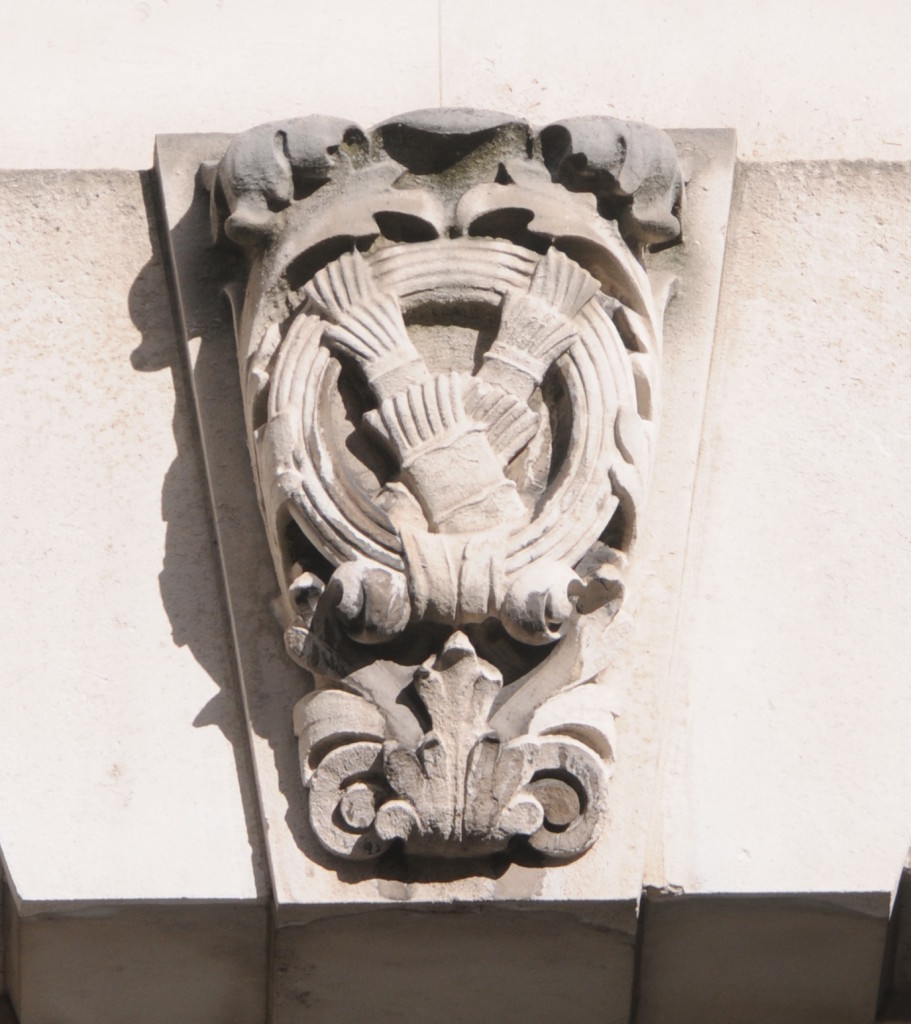 Cables were the key part of the telephone system that carried the pulses and speech from telephones, to the exchanges and then across to their destination, whether in the same street or across the world. (I can see the architects were trying to tell a story in stone of the technology of how a telephone call was made)
Cables were the key part of the telephone system that carried the pulses and speech from telephones, to the exchanges and then across to their destination, whether in the same street or across the world. (I can see the architects were trying to tell a story in stone of the technology of how a telephone call was made)
The next carving shows a Horse Shoe Magnet. Magnetism was key to the telephone system from the very beginning through to the late 1990s when telephone exchanges driven by magnetic devices were replaced by computer based systems.
Michael Faraday’s work with electricity and electromagnetic induction was critical in the understanding of electricity and magnetism, their relationship and laid the foundations for their future practical application. This work was crucial to enable the technology that would go on to provide the telephone systems that spanned the world to be developed and these carvings clearly seem to be celebrating this fact, and the position of the Faraday Building as a hub in this global network.
One of Faraday’s experiments involved rotating a coil of wire between the poles of a horseshoe magnet which resulted in the generation of a continuous electric current in the wires of the coil. This was the first electrical generator and the fundamentals are the same in the generators of modern-day power stations.
We then come to a carving for King George V, the monarch at the time of the construction and opening of the Faraday Building.
Moving on we come to the carving of an electromagnetic relay which to me is one of the most unique relatively modern-day carvings you will find across London. It is of a core bit of technology, hidden away in the depths of a telephone exchange, but without which automatic telephone exchanges would not have functioned. This type of relay was cutting edge at the time the building was planned, equivalent to the technology that connects the Internet today and switches information from your computer or smart phone through to web-based services across the world.
As an apprentice in the late 1970s with Post Office Telephones (as it was prior to changing to British Telecom and being privatised) I have spent many hours cleaning and adjusting these relays to keep them working and driving the equipment that switched telephone calls. The following photo shows a typical item of equipment from a telephone exchange in the late 1970s full of the relays found carved on the Faraday Building. This is looking end on, as if we were looking at the carving in from the right.
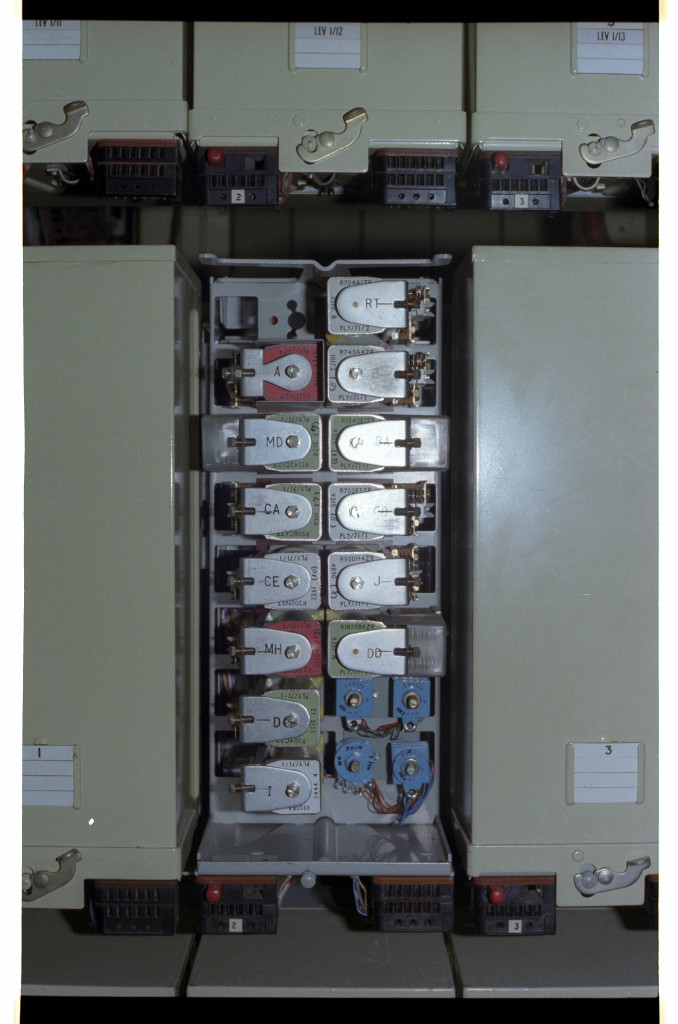 Large telephone exchanges such as that within the Faraday Building would have had many thousands of these relays.
Large telephone exchanges such as that within the Faraday Building would have had many thousands of these relays.
I find these carvings fascinating. They show a pride and celebration in the technology of the time and the function of the building. The majority of buildings constructed during the last few decades, apart from transient corporate logos, tend to have no indication of their function or purpose.
One final set of details can be found just above the main entrances to the building. Just above the door, between the words Faraday and Building is the caduceus (staff with wings above two coiled snakes) of Mercury, the messenger of the Gods, and just above the window there is a carving of Mercury.
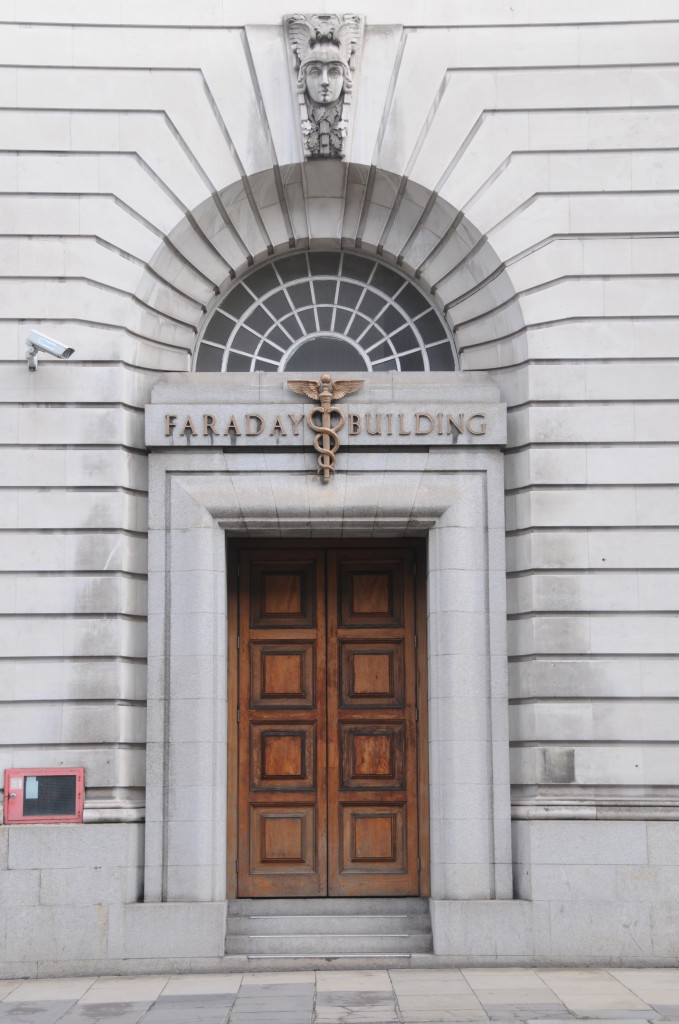
Technology has moved on considerably since the Faraday Building and these carvings were completed and I doubt the architect and builders of the time could have dreamt of the Smart Phone and Internet.
I hope these carvings remain for many decades to come to show future generations the pride that they had in the service that the Faraday Building would provide to London.

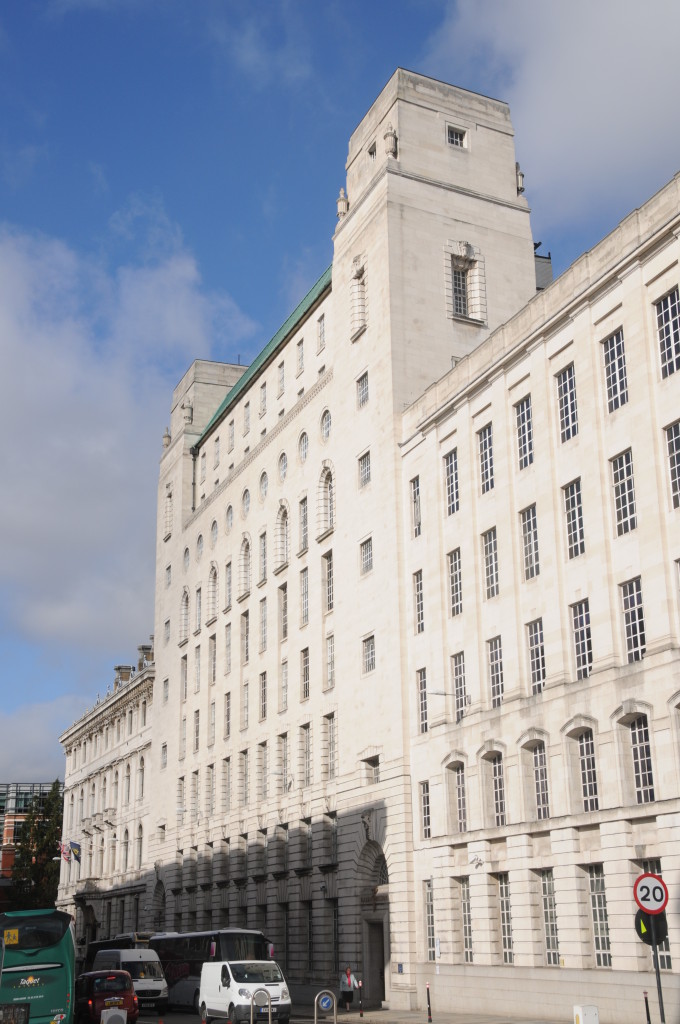
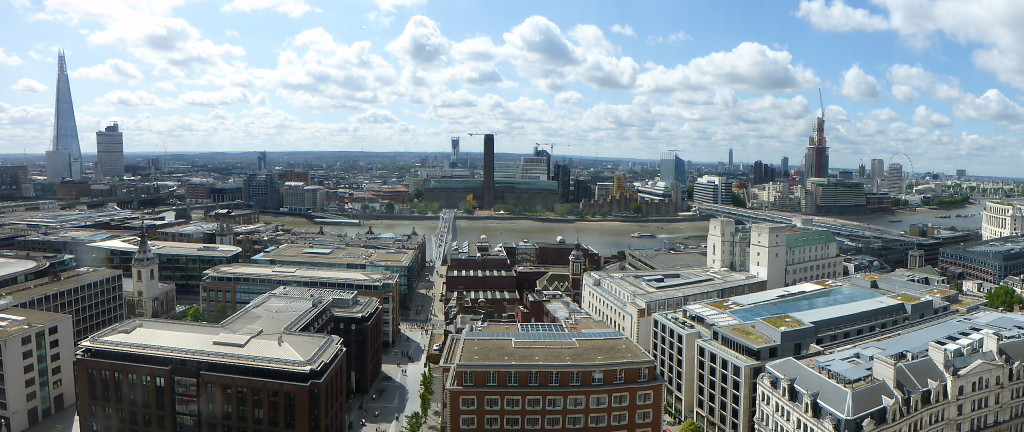
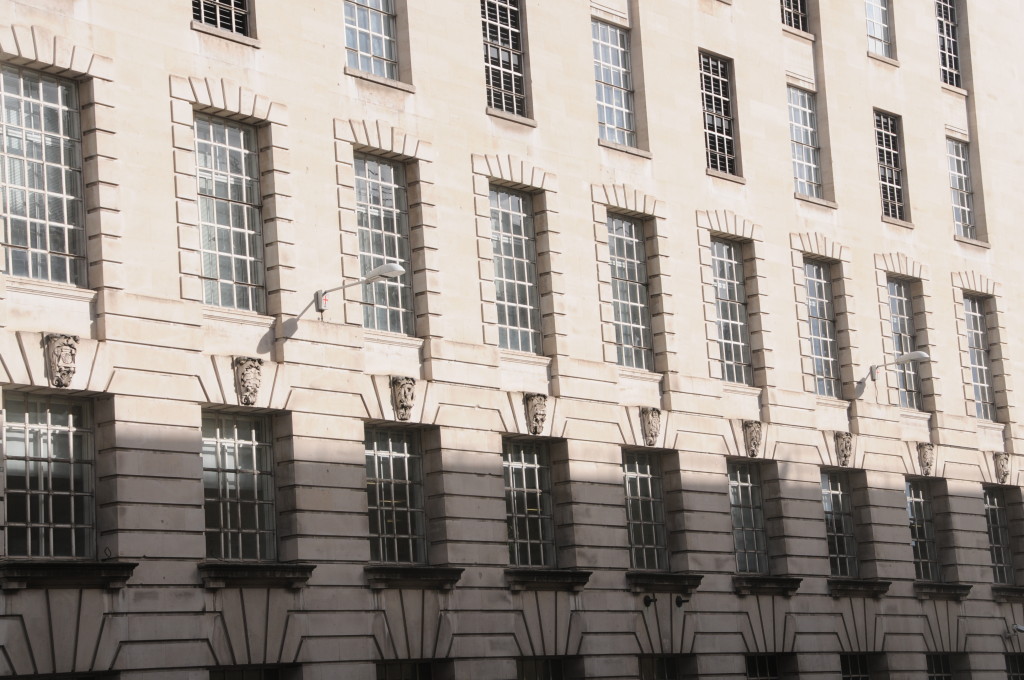
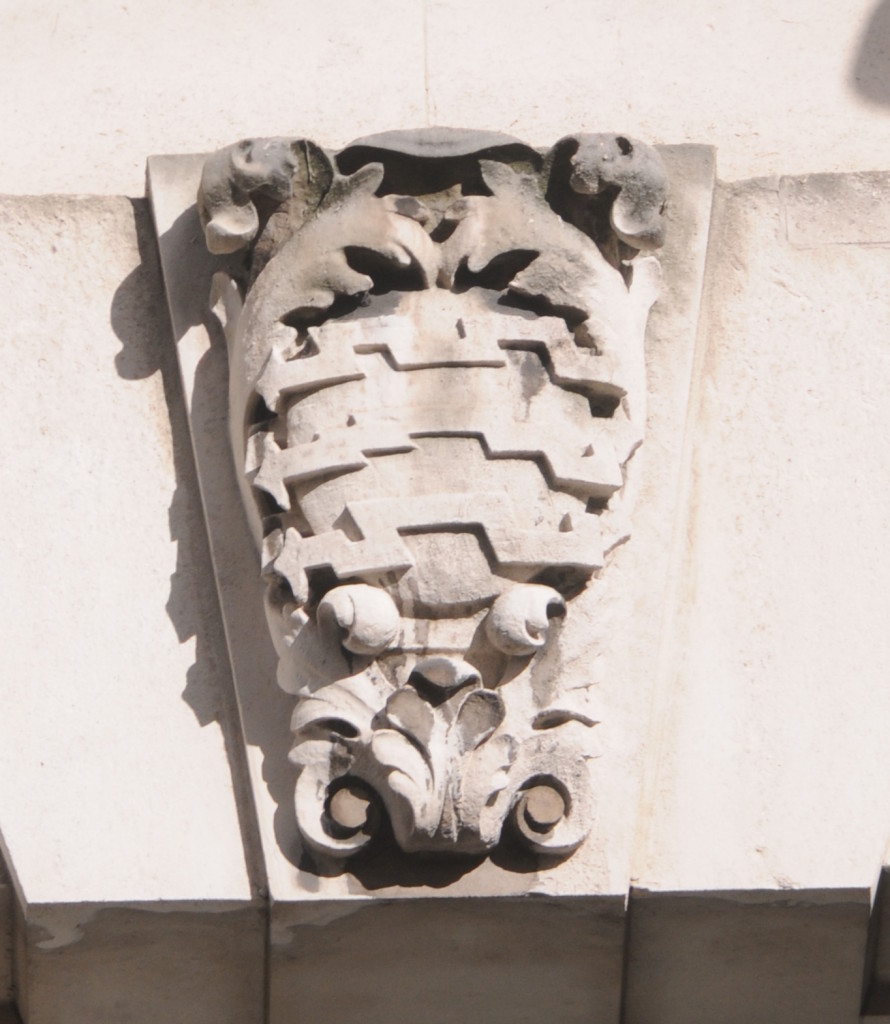
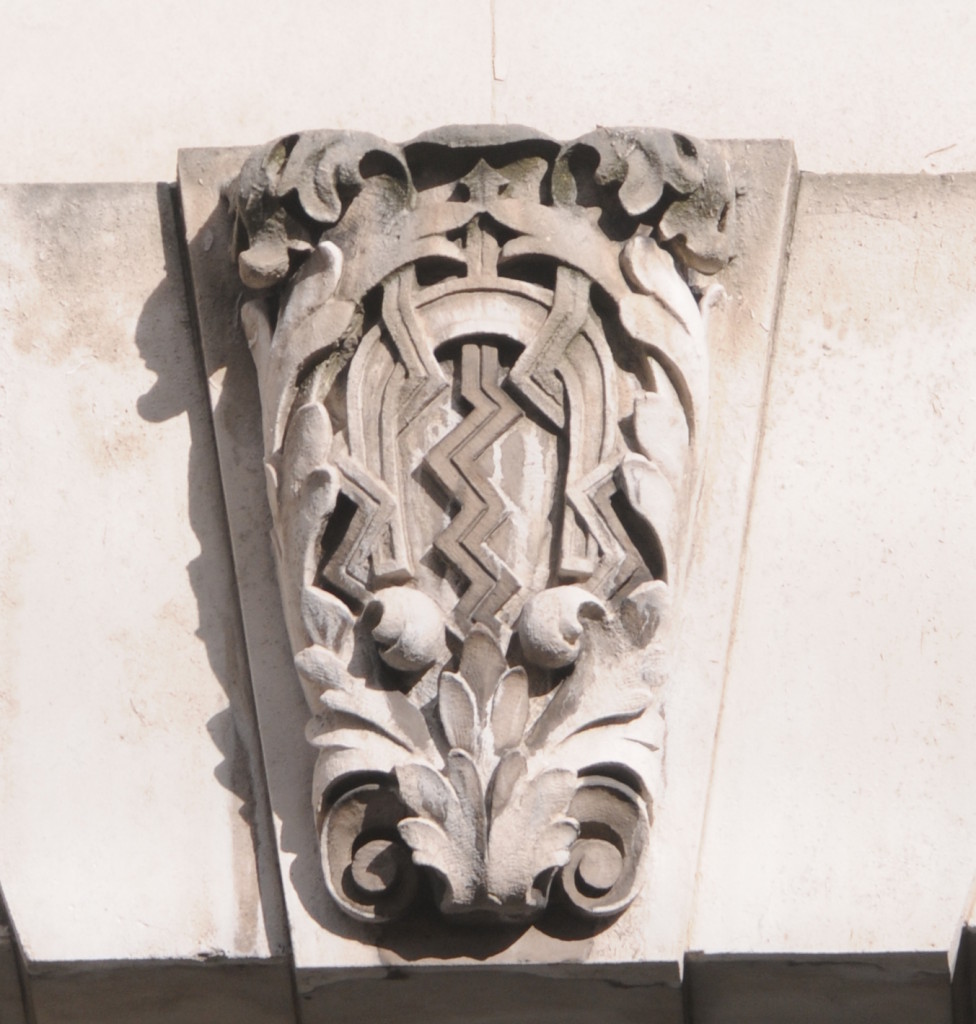
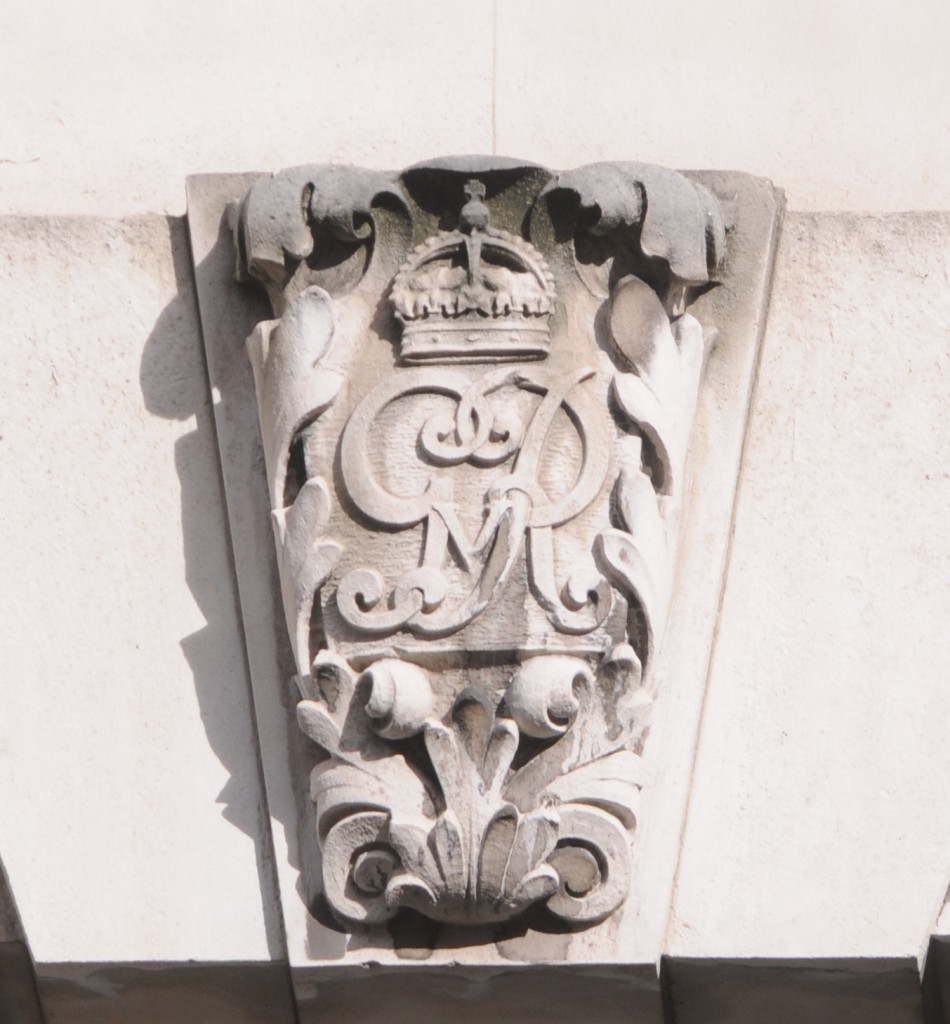
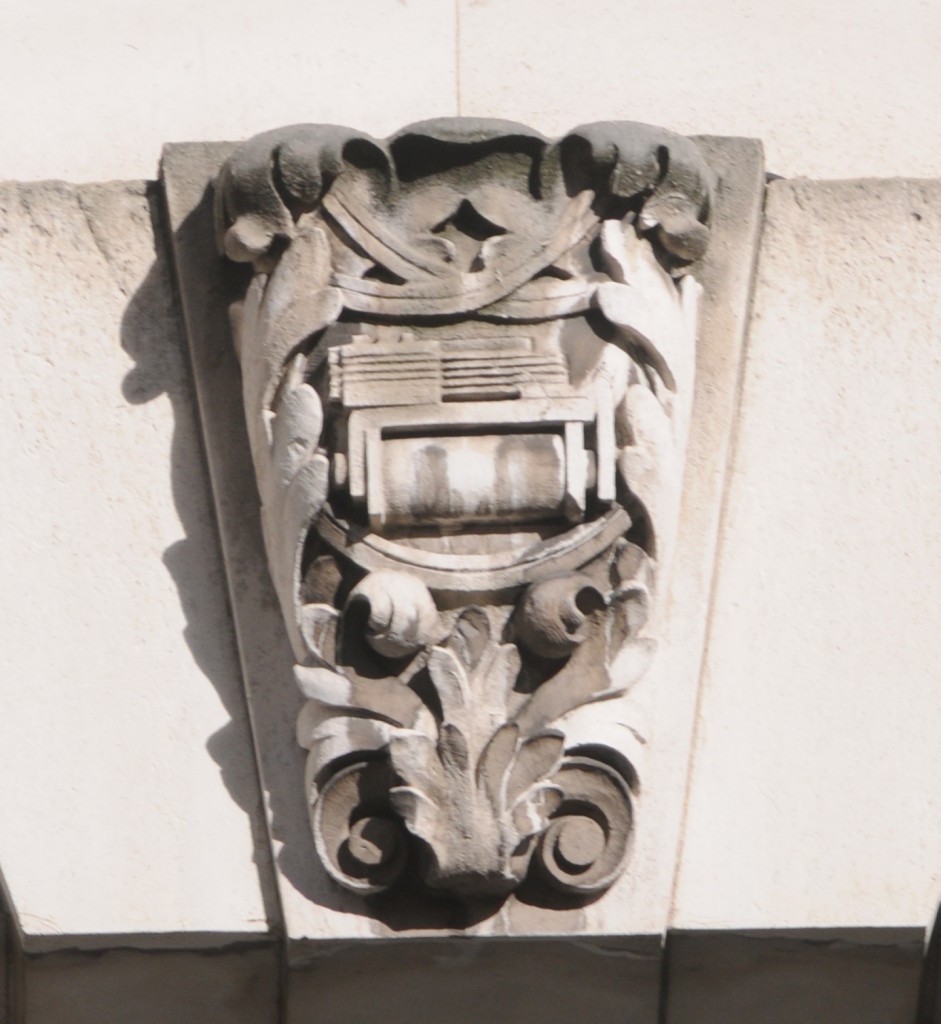
Pingback: London News Roundup | Londonist
Found your picture on Twiiter and just wanted to say thank you for bringing back lots of happy memories.
My Father worked there in the 1950’s and each year we would go with him to the Faraday Exchange for the kids Christmas party.
Hi Andy, thanks for the comment. I gather there was quite a social life associated with working at Faraday as there was a considerable staff there for both the engineering support of the Exchange and also all the operator services that the telephone service was so dependent on.
I was one of the telephone operators during the war, it was a testing time one never knew if the building would still be there each day, especially after the great raid on the docks and a lot of the city left burning. However we lived to tell the tale, and soldiered on. I left the service in 1955 my last exchange as supervisor in Flaxman. I doubt if any of my contemporaries are still alive, they would be 80’to90 years.
Elizabeth, thanks very much for the comment. I can imagine it was a very testing time. I understand Faraday was “relatively” lucky as there was considerable damage throughout Queen Victoria Street. It would be very interesting to hear of your experiences at Faraday during the war.
Well, I’m still alive at 91 and I was a Girl Probationer there working in the Trunks div. also in the Citadel, the building behind Faraday. I went on to Victoria exchange later. My best friend worked at Faraday too and was in Toll. Div.
Hi, my mum Vi Turner worked at the Faraday during the war. She would have been 93 now. She had lots of amazing stories about her time there and always spoke fondly about it.
I worked here in 1959/60 in the incoming call centre . I was only 15yrs old and just left school . It was the best job I ever had and only left as my parents decided to move to Cornwall where I live today. Lovely memories of a beautiful old building . Kathy Thomas (nee Jewell).
Hi Kathy, I have heard from several people that it was a great place to work. I am just so glad that the carvings have remained on the front of the building, as a long term reminder of Faraday’s key role in the telephony system.
trained at Faraday for the good old GPO.Brings back such good memories I worked in the exchange round about the 70s such a good place to work and meet new friends
Hi…my name is Jenny Bean i left school 1965…trained for 6 weeks to become GPO. Operator … Then took up Telephone Operator position at Faraday …I throughly enjoyed working in the lovel old building. the switch room seemed enormous at the time…At lunchtimes we went out onto the big balcony around the roof….the view over London was amazing…I was only just 15 at the time…so it seemed like a good adventure.
Hi Jenny – it must have been quite an experience at the age of 15. I have only heard good experiences from anyone who had worked in Faraday. I bet the view from the roof was amazing as at that time it was still one of the tallest buildings in the area.
Hi Jenny, just came across this site. I also worked at Faraday building in 1965 having just left school at 15 and can remember doing my 6 weeks training at another exchange.
I loved that job but sadly everything changed when my father was posted to Devizes in Wiltshire, I did work for the little exchange there but it was never the same and soon afterwards STD took over. My maiden name was Nottage. I only have memories of my time at Faraday, we didn’t think to take photos back then.
Val Carter
Hi Val my name was Valerie Clark then and we were friends back then. Both started at 15 .
My supervisor was Miss Stott. It was a great building to work in, many memories.
Hi, I was a TO installing SPC in SE Block in the early 70’s. The building was alive and buzzed with all the engineers and operating staff and there was a family atmosphere and great social life. I visited it in 1995 and nearly wept with the emptiness of the place. All the equipement gone and just a few silent grey boxes in corner calling themselves a telephone exchange. Sad, but thats progress for you.
Just came across this by chance but great to see the carvings and their interpretation. I worked there during most of the 80’s but I must say I didn’t really take notice of them at the time. It was a great place to work (subsidised bar, snooker and table tennis tables etc.). We sometimes spent time ‘exploring’ all the hidden areas of the complex and marvelled at the massive steel doors into ‘citadel’ (North block). One room we came across resembled a greenhouse with virtually the whole of the windows obscured with plants – we wondered if anyone actually knew what the men in there did, apart from tend the plants!
I was a French speaking telephonist here in 1974. A 19 year old girl from the north west. Totally unaware of the great history behind the famous building I was working in. I used my lunch breaks to explore the area. We were in the middle of the “troubles” and often had to leave the building and go down the winding staircase and make our way to the steps of St Pauls whilst they investigated the bomb threat. Scary but necessary, after a while we got used to it and just carried on working. It was an incredible place to work. I feel very privileged to have spent a couple of years there.
I worked as an engineer in Faraday from 1963-1971 and again from 1990-1998.I have great memories of those years.I even married one of the telephones. I worked on the 1st floor southeast block and can remember taking my kids in to watch the Lord Mayors parade going down Queen Victoria st.
As everyone has commented, Faraday Blg was a great place to work but even better to explore. One day a colleague and I descended the many steps down to , what we were told was six basements down and looked in awe at the coming together of all of the telephone cables from North London before they went under the Thames to come up at Colombo House on the south side. If we had been caught it would have meant a disciplinary offence, but it was still rather spooky and scary down there.
I was a telephonist at Faraday in 1974. I was trained by Mr Fitzgerald and Mrs Benson. My co-trainees were Karen Wiseman, Ruth Durrant, Mrs Lilly and Mrs Crocker, Debbie, Shieila, Jill Armitage and Mary. I also remember Julie Aldridge and Rehanna Rashid, and Jo with whom I shared many a giggle!
I loved working at Faraday. It was the best job I ever had.
Hayley Morris, nee Denny
Hi, I’ve just found this page when trying to find photos of the telephone exchanges at Faraday House. What a brilliant page,with the building just as I remembered it. I was sent to Faraday after my initial training as a telephonist in 1949. I was 15 and I just made the height of 5ft,which you had to be as a telephonist. After the first week or so when we were in the “dummy” switchroom,which was underground,we were then moved into the main building. I was allocated to 3main,which also had the Royal switchboard in. I remember if we were late to work,we were docked pay for every half hour. We had special dockets for the canteen,so we didn’t have to pay full price,although I’m not sure if that was only while we were juniors. Once a week we had to attend school in Holborn,where we had lessons on maths, english,and other subjects.
I really loved my time there and was sad when I had to leave. I ended up at Enfield Telephone Exchange, until I moved with my husband to Bishop’s Stortford. I then went on to other jobs, but the GPO was definitely my favourite,and I still have fond memories of it. If anyone was in 3main during the late 40’s,early 50”s,I would love to hear from them.
Tnanks once again, Jean
Dear Jean, Sorry to trouble you but I have been trying to track you down in relation to an interview I would like to do with in relation to a BBC documentary I am making about Switchboard Operators; is there any chance you could drop me a line at all? I am on james.harrison@bbc.co.uk happy to explain more about the documentary etc.
Many Thanks
James Harrison
BBC Studios, Bristol
I came across this post as I was curious as to the history of a building that I visit from time to time in my work for an internet service provider. We have equipment located on the ground floor in the MUA (multi user area) I like the fact that the buildings use has evolved over time with the changing shape of communication. I also love the view from the 9th floor canteen over St Paul’s, many a top London restaurant/bar would kill for that.
Thanks for the informative post and I will be on look out for the 2nd floor stone carvings next time that I go.
Hi Iain,
Just seen your post about Faraday House. Do you know if the underground room is still there?
I don’t suppose any of the old exchanges are left there now,but this fascinated me as a 15 year old.
Jean
Hi Jean,
I only have card access to my the area we have equipment in Faraday, however my colleague is going next week Or I might be going before the end of December I can ask one of the guys on the Securuty desk for you.
Thank you so much for this information. My mother was very proud of being a GPO trained telephonist. While dealing with her effects I found her membership card of the Faraday Building Refreshment Club for 1947. It showed her exchange was Toll. She told me that she used to take her breaks on the roof and look out over London. I also recently found out that the telephonists worked shifts and slept in specialist accommodation where they were also served breakfast. All that and wages too! Her family home was able to have a telephone because of her job although it had to be registered in her name rather than her father’s. We never knew that this was the building she worked in (after all she had signed the Official Secrets Act) but I can now understand why her Mum was concerned when she saw the size of the building her daughter was working in. RIP mum
Hi Dawn, that is really interesting. I have had a number of comments from people who worked in Faraday and everyone appears to have enjoyed their time working in the building. It must have been a fascinating experience, with the added benefit of the opportunity of the view from the roof. It would be interesting to know if anyone ever took any photos from the roof.
Hello I have just found this page about the Faraday building i worked there as a G>P.O telephonist in 1959 -60 I worked in 6 S which had the royal board the stock exchange and Irish service we also dealt with calls coming into London from all over the country to be diverted to other parts of London, although the main room for incoming calls was 5 main, there was also the continental exchange in the building and the international exchange, the view from the roof was fantastic and it was lovely to sit outside in the nice weather.
Hi Linda – thanks for the comment. All the feedback I have had on Faraday is that it was a really good place to work. I am envious of the view from the roof, I bet it was fantastic. I will have to search for some photos.
Hello Linda,
Well! Faraday obviously changed from the time I was there, because the Royal Board
was in 3main then. Also there were separate Continental and International rooms. Not sure
of the number rooms, but they were on the upper floors.
I should have taken photos when I was there in 1949,especially the “Dummy room” which was
outside the main building.
Lovely to hear from other people who worked there.
Jean
Hi Linda just wondered if you knew my mum Barbara Edwards who was probably there at the same time
OMG this was such a lovely surprise to find this.
I did my training at the offices near Camnon Street station an dremember the walk to Faraday building which we all moined about, but we were young. I worked in the Continental Exchange and i loved every minuite and i am so grateful for the training i received because it gave me the ability to work for years and employers always wanted GPO telephonists. I now live in the north east of england but would like to know if there are any tours of the exchange as i would really like to go back and remember my very happy days there.
Hi Christine,
I am an ex-telephonist from Faraday House, and I can tell you that there is definitely no tours around the exchanges as they have now all been dismantled. If however you just want a tour around the building,
you would have to ask someone else,because I don’t know.
I was told way back in the 80’s I couldn’t go in the building,when I especially went to Faraday to look at it.
Hope you get better luck than I did.
Best wishes, Jean
Hi jean
I am going to be in London in June sometime so I’m going to start making enquiries and see if there is anything that can be done so I will let you know if I gat any where
Christine
Keep your fingers crossed
Just found this site and all of the interesting posts by former telephonists. As I could speak French I was accepted to work in the Continental exchange in the late fifties. have fond memories of the people that I worked with, many from Europe with fascinating tales to tell of their life in wartime. Quite an experience for a young English girl from the country to be in the big city and meeting a diverse group of coworkers. The supervision was quite strict and the discipline served me well when I worked in the USA. on a hospital switchboard and later in a publishing company. Now married and living in the USA but visit London often and always wondered what happened to Faraday House, as we called it.
Hello Yvonne, How lovely to see on the Faraday House post, that you worked in the Continental Exchange
at Faraday. You were there about 4 or 5 years after me,so at least you remember it as it was when the
discipline was firmly in place. My father wanted me to learn the Dutch language so that I too could go into
continental,but I didn’t unfortunately. However I was in 3main,and got to know lots of people,a couple of my own age,so we tended to stay together when we went to lunch etc, Did you go to St.Paul’s Cathedral? We did,
and went up to the whispering tower. All those steps, couldn’t do it now!!
Anyway, I’d better stop now before I get carried away.
All the best, Jean
Hi Jean,
Yes we used to go to St Paul’s and sit on the steps eating our lunch.
People are writing about going up to the roof of Faraday House but I never knew about that. Perhaps it wasn’t available in my day. Would have enjoyed the view over London. This site really brings back memories. Yes, the discipline was fierce! Must admit that I wasn’t always on time for my shift and had to undergo quite a drilling on why I couldn’t get to work early enough: “Did I oversleep? Did I go out and party in the evening? What time did I go to bed? ” I think that with so many young girls, perhaps their first time away from their parents, that the Dragon Lady (as we caller her) was a bit worried that we were being led astray! NO, it was just that I liked to sleep late and always underestimated the travel time. Must admit that even after 60 plus years I am still the same.
Oops I did get carried away. Nice to hear from you Jean.
Yvonne
So thrilled to see all the comments about Faraday house I left school at sixteen in 1958 and trained as a telephonist on the continental exchange.I particularly remember being on the switchboard when the call came through about the football Munich air disaster we were all very upset.we went to Holborn one day a week for other lessons,mine included Spanish,can’t remember much though.
I went to St Pauls after work at one time to hear Paul Robson sing the Messiah which was wonderful.
I lived in a civil service hostel in Sloane gardens and travelled on the tube to Blackfriars for work.
It was a good training which carried me through three years in the Air Force as a telephonist and the other jobs through other periods of my life.
I’ve kept coming back to this page over the last few years. I worked as a telephonist at Faraday 1964 – 1966. We had I think 3 months training off the boards in an office along Queen Victoria Street, then several months on the boards before going for linguist training in a language laboratory. I remember a number of the people I trained with, but once we started on the boards we tended to lose touch with different shifts etc.
Hi Christine,
I’m afraid this was way after the time I was at Faraday (1949-52), but it is interesting to see how the training changed over those few years. I think I had 3 months training,the same as you, but then we were sent to Faraday and worked on the “dummy” boards which were away from the main building,and we weren’t there long before we went into the main building,in my case 3M. I loved my time there and was sorry when I had to leave to go nearer home.
I never took much notice of the streets around Faraday until quite recently,when I picked it up on google,and saw all the embellishments on our building. Now I can’t get there to have a proper look,so have to content myself looking online.
Lovely to kow that other people remember working there. I wonder if anyone else remembers the dummy boards in the outbuilding?
Jean
Good to hear from you Jean. I enjoyed my time there too, but got married and moved to far to continue. I loved the international atmosphere with many languages being spoken everywhere.
One of the main memories is that I was able to watch Winston Churchill’s funeral procession into St. Pauls from a window on the staircase on the way up to the canteen!
I too would love to walk those streets again, I lived opposite the British Musuem, and would walk to work along High Holborn and down Ludgate Hill into Godliman Street. Those were the days!
Hi Christine,
Many thanks for your reply. Like you I had to leave after a couple of years,when I transferred to Tottenham telephone exchange,then in 1953 to Enfield exchange,which is where I lived. 1955 I married,
and then in 1957 we moved to Bishop’s Stortford in Herts. I then decided not to work at the exchange there,but that was a bad move,as I could have got a transfer. Instead I took a job as a part-time filing clerk (disaster), it was so boring,and I regretted it.
Still, there you go,hindsight is a wonderful thing. Anyway in 1960 we returned to Enfield and have been here ever since.!!!
Bye for now, Jean
My dad worked here for most of his career, from after the second world war until he retired in 1983. I remember visiting him in his office in the early 70s. He as an STS – senior traffic superintendent. I could never discover what this meant, perhaps someone here can explain.
I was an Telephonist (LFICC/E) from 1977-1979 working in the 4A & 5main Switch Room in Faraday Building Carter Lane. What Fun we had !!!!! When speaking with younger people today they do not know what a Switch Room is and have no concept that you could not Direct Dial Over Seas
I was at Faraday as a telephonist (LFICC/E) from 1978 then transferred to Wren House . I married a soldier in 1983, then I moved to Army quarters in Hameln West Germany in Feb ’84.
I can still remember crying as I walked over Southwark Bridge, to pick up my voluntary redundancy cheque from a building there.
I loved working at Faraday and Wren House, it was a great learning curve for a 17 year old, who had never been to London.
I met so many lovely people, but lost touch over the years.
I still have one friend I made at Wren House , probably nearly 40 years of knowing her.
Good times and memories!
Hi all, my mum recently passed away and I’m doing some research into her life. She worked as a telephonist at the Faraday during the Blitz in WW2 and had many stories. One that sticks in my mind is her tale of helping the firemen up the stairs with buckets of water every night. London was being firebombed and mum was told that the Faraday was one of the few buildings in London that must be saved ‘at all costs’ due to it’s underground connection to Whitehall.
I’m sure she once showed me a photo of her and some friends on the roof with a wind-up record player with the bomb damage behind them. I will try and find it.
Hi,
Can’t help with the wartime period because I was there in 1949, but the underground connection to Whitehall was used after the war for our training before going onto the real switchboards. Very interesting and great fun.
Hi Jean, it definitely seems like it was a workplace that stayed with you for life! My mum often talked about her time there and the friends she made. I think also it was so exciting for her as women weren’t really ‘allowed’ to work in jobs like this before the war but suddenly they were very much needed!
HI ALAN,
YES, FARADAY HOUSE WAS MY FIRST PLACE OF WORK AFTER SCHOOL ,AND I LOVED IT. i WAS ONLY THERE FOR 2 YEARS BEFORE MY DAD DECIDED HE WOULD RATHER I WORKED NEARER HOME. I WAS
DISAPPOINTED, BUT DID AS I WAS TOLD AND MOVED TO TOTTENHAM TELEPHONE EXCHANGE,THEN IN 1953 AFTER I GOT ENGAGED I MOVED TO ENFIELD TELEPHONE EXCHANGE. I NEVER WORKED ANYWHERE ELSE THAT I ENJOYED SO MUCH.
JEAN
Fantastic to find this site, l worked as a continental telephonist from 1969 to 1982 and then next door to Wren house until 1989, when l was then medically retired. It was a fabulous place to work, and have many happy memories, it was a very interesting building and there was just as much below ground as above. Would love to hear from any of you from that time
I worked at Faraday in 1978 then in Wren house until Feb 84 My name is Lesley Coleman (Wickenden)
I started work there in 1949 in 4 main which was the trunk exchange and my supervisor was miss Baker,made many friends and we often used to eat our lunch up on the roof and listen to St Pauls choir boy’s practicing in the next building.
I have a photo of 4main dept which was an official one, I left Faraday to transfer to Woolwich Arsenal exchange after many happy days.
How lovely, someone who started work at Faraday the same year as me. You are the first person I’ve heard who is from that year. I was in 3 main,which had the royal board in, but it was only special people who were allowed to operate it. We used to have our lunch mainly in the canteen subsidised,of course as I was only
15.
Like you I made lots of friends while there and our supervisor was Miss Mallinson. Now, how do I remember that? It”s 65 years ago. Anyway, like you I transferred to another exchange, and that was Tottenham, North London, but Faraday was always my favourite.
Jean Singleton
I worked at Faraday from 1948 -1950 I was in 2 main.I left to do nursing training.I remember going on to the roof during lunch breaks.
I worked at Faraday from 1948 – 1950 in 2main.I left to to do nursing training. I also remember lunch breaks on the roof.Joan
I was a GPO trained telephonist at Faraday – Their excellent training set me on the path for a life long experience of customer service – currently known as a call centre. ! Very happy days at Faraday, memories of lunch breaks on the roof and my lovely dolls eye switchboard. Yes we all signed the official secrets act – I was in the same room as telephonists on the Royal Board, who spoke to and connected calls for the Royal Family….. Lovely days
I worked at Faraday from 1964 to 1966. Spent time on the Royal Board, and was selected to take people and groups on guided tours of the exchanges. Supervisor was Kay Coull, a lovely lady. Remember the lunch times on the roof enjoying the views. Good times and good friends.
That’s when I was there! I started training in October 1964 and was on the boards by January I think, with linguist training taking me out for several hours a week from then on. I remember a few names but not yours or Kay’s. I left in June 64 – it was a mistake!
Just found this fascinating page which brings back memories for me.
I worked the switchboards at Continental for a few months around 1960. My training was brief because there was a shortage of specialised operators, which I will explain. I haven’t seen it mentioned elsewhere that the Continental night operators were all men. It was a sex division that went back to the early twentieth century when it was considered improper for women to be out late at night. As a result two unions formed, one for the men and one for the women, and each union guarded its turf. The change of gender came, I think, a 6 pm. If traffic was heavy and we wanted to keep some of the women on into the evening, we had to get permission from their union representative. The other particularity that I haven’t seen properly explained elsewhere was that we male night operators had to be bilingual in English and French. In fact that’s what got me the job. The reason for this was the international agreement that English and French would be the only languages used for international telephony. Consequently several of my colleagues were university students from bilingual colonies like Mauritius. The GPO tried to get this changed to English only but came up against insurmountable opposition from two countries, namely France (of course!) and (surprise!) the Soviet Union. The Russians only had a very limited supply of foreign language operators and they had all been trained to use French.
Could say more, but that’s enough for now.
I agree about the men doing nightshifts but I can remember working until about 10.30 or 11 and walking home to Holborn arriving home at about 11.30. so it wasn’t that strict about us being out late. I wouldn’t want to do it now!
Regarding men doing night shift, this also happened in 3main. This was 1949 and I think the
ladies could work until 8pm although 6pm was the normal time.
Can you please Help. I need to contact the Continental Telephone exchange, Faraday House concerning my past employment. Can you please give me an email address for me to contact the employment records dept.
Thank you
Alice
You need to contact BT at their headquarters which is BT Centre Newgate Street, St Pauls.
Hi, The latest edition of People’s Friend special edition has an exchange photo and a one page article on the continental exchange in the 70s
How lovely to read about Faraday ! I started in the French speaking exchange on June 1st 1970 and was there until I left to get married (2nd time round) in December 1973. I was on strike for 8 weeks from the beginning of 1971 and became UPW rep when the strike finished. I transferred to Portsmouth local exchange in January 1974 and hated every minute. I stayed with BT until July 1992 when I took early retirement at 50, having progressed from telephonist to Manager. Such happy memories of Faraday.
Hello was just looking for Faraday Buildings and was taken back to the late fifties when I commuted from Uxbridge tube station into the city. Having learnt french as an au pair, I thought to try my luck as a telephonist with the intercontinental exchange. Six months later inspired by the ads. on the tube, there were three of them, a typist, a telephonist, and an air stewardess, (Amplex tablets for fresh breath) I moved on to have a career with our National Airline.
I now find myself at the other end of the Piccadilly Line (Southgate). Age has taken away my mobility, but it has left wonderful memories, strange how much history has become part of our lives, little did I realise that my very first job, typist with systems research at Cadby Hall (J. Lyons) was my first brush with the internet, which now gives me hours of pleasure, and help.
I worked at Faraday Building in 1965 for about 3 or 4 years and was trained by Hazel Carless to work in the French speaking part of the exchange. I still have a booklet which I got when I worked there, explaining the workings of the place. I also have a photo which was taken by a professional photographer of me (amongst others) working on the switchboard. Great times, althugh I didn’t realize it at the time. I am still in touch with one of the girls who worked there and remember many names. Anyone remember me, Pat Williams?
We were there at the same time, but I don’t remember you I’m afraid. Our initial training (from September 1964) was by George Murkett in a building near Mansion House. In about February we went to Faraday and I think were working with Sue Christopher. Our language training on the board was with Mrs Alexander. About the only name I remember completely is Clara Olink – we trained together from the start. Oh, Joanna Shears as well. I remember faces but not names 🙁
Hi,
Going back to 1949, does anyone remember either Jean Stanners,who left later to work in racing stables,
or a girl called Maureen, who lived in Camden Town,and she reckoned she was the girl friend of the leader
of a gang in Camden. How true this was I never found out.
Lovely to see so many reminicences about Fardy,sows how it was loved.
Jean
Hello, While researching my grandfather Frank Jackson I came across the following little known incident involving the Faraday Building in WW2 which is recounted in Richard Colliers book “The City That Wouldn’t Die”
Jackson was the Officer in Charge of the London Fire Brigade from 1939-43 under various titles and Churchill had personally directed him to safeguard St Paul’s. In Colliers book he describes some of the events in London on the heaviest night of bombing during the Blitz. Early on the morning of the 11th May 1941 the fire brigade had completely run out of water in the City. Normally it would be be pumped from the nearby Thames, but that evening the river was at extremely low tide and this meant the pumps were unable to operate. Jackson was now carefully considering the awful decision he alone had to make that could place the Cathedral in jeopardy. Standing on Queen Victoria St he was on the verge of ordering a firebreak to be created on nearby Godliman St. This would have entailed using explosives that could have seriously damaged the foundations of the Cathedral. The reason he considered taking such drastic action was because fires were close to endangering the nearby Faraday Building which at the time was the nerve centre for Britain’s wartime overseas communications and had to be saved at all costs even taking priority over St Paul’s. Its importance was so great a minister was always stationed here overnight secure in a concrete bunker deep in the Citadel.
Fortunately just in time a convoy of trucks carrying water from Regents Park Canal arrived and the threat to the Cathedral was averted.
I’d love to hear from anyone who has information from any other sources about this event.
Frank
I worked there for a company called Cresta Communications in 1985, we were a venture captial company I believe the first to do elctronic funds transfer at point of sale (EFTPOS) using a terminal called Teletran which was in garages and shops to swipe credit cards. BT had a large chunk in the business and we had a number of large C&A shores in Reading and Guildford, a few sites I can’t remember. Think we had a couple of rooms on the third floor
We had special permission to visit the replacement exchange, it was housed in a relatively small room in the corner on a cavernous floor !
I was a TTA and subsequently a T2A at Faraday between 1968 and 1980 After serving my apprenticeship I ended up on exchange construction. EDI24 if I remember properly. As a bunch of youngsters we had a great time. We had a store room way underground where we brewed beer! and occasionally had to smuggle it up to the exchange floor via the ENG switchboard and line test facility.
I also used to spend lunchtimes on the roof with my ham radio buddies. We had great fun at Faraday but it didn’t do much for the work ethic, it was a real shock when I left to join the outside world!.
Hi my name is Judy Douglas (nee Brown.) I worked at wren house from 1969 to 1974 and then Faraday lings from 1974 to 1977. I wouldn’t have missed it for the world. After passing a test I was trained for french speaking for 8 weeks in Holborn before going in the switchroom. I made some wonderful friends – one who became friend for life. The GPO working years were definitely my best . It would be lovely to hear if anyone was there same time as me. I also had lots of friends in the non-lings as we all used to meet in the canteen together on our tea/coffee and lunch breaks. It was a very sociable place. wonderful memories.
I completed 5 years in the IX switching exchange 1972>1977. Great times.
I just stumbled across this site whilst looking up Faraday Building, I was explaining to a friend that I worked there in 6S exchange when I left school at 15, from 1972-1974. Looking back now it was the best job I had, despite the strict Supervisors whose names I can still remember lol, I really enjoyed being a Telephonist. 6S Exchange covered the Irish Service calls, many a time connecting people in phone boxes making calls to their relatives in Ireland. And telling them to “put more coins in” as time was running out. A lot of places weren’t direct dial back then. We also connected the World of Sport conference call on a Saturday.
I would love to be able to do that job again, I can still remember how to connect the calls, although technology has changed so much now.
I still love phones, nowadays it’s iPhones instead of Dolls Eyes!
I’ve just started taking my state pension and still working a couple of days a week, now in retail. At least I still have many happy memories of working in Faraday Building 6th floor exchange.
Was lovely reading all the previous comments on here.